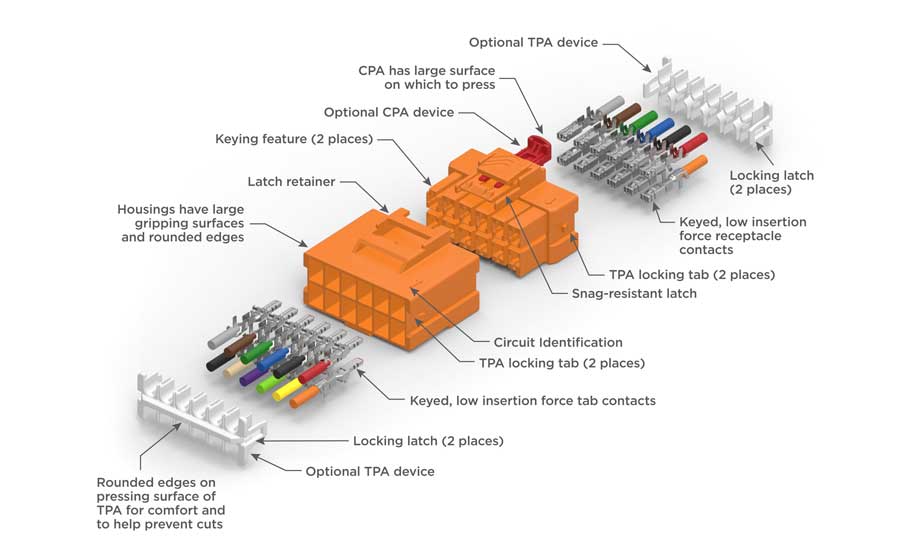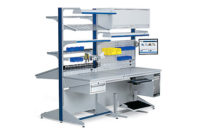Various types of connectors are used in home appliances and air-conditioning systems to create reliable contacts between different parts of electric circuits. In recent years, the number and types of connectors have multiplied as advanced sensors, controls, and communication/networking capabilities are incorporated into more intelligent appliances. Each connector must be properly assembled to minimize signal distortion or power loss, but also to meet the required pressure resistance and mean-time-between failure (MTBF) of connect/disconnect operations over the product’s lifetime.
Although robots and automation are used for some connector-assembly tasks, many connectors are still assembled by hand. To minimize human error, manufacturing engineers are proactively identifying ergonomic issues that affect worker and connector performance. Applying the insights of ergonomics—the science for optimizing the design and arrangement of the work environment—can improve workplace efficiency and safety. By understanding common trouble spots and implementing best practices, an appliance manufacturer can ease the human strain of assembly, reduce worker turnover, and prevent errors to minimize in-warranty service calls and repairs of products in the field.
Common Ergonomic Issues in Connector-Assembly Operations
Years of experience reveal many common problems that occur when workers spend hours assembling connectors. Many trouble spots are obvious; others are easy to overlook. Key issues that arise when connectors are assembled in the manufacturing workspace include:
Reducing insertion forces
Issues: The pounds of force that a connector requires to be properly mated greatly affect worker stress and productivity. When lower pound-force can be used to create a normal contact, the worker’s task may become easier. Insertion force is a factor of the coefficient of friction, resistance to abrasion and other mechanical variables. Connector design and materials play a key role in reducing friction. For example, a tin-plated brass receptacle terminal designed for low insertion force (LIF) requires six pounds (27 Newtons) of force on average, which is 40% to 60% lower than the ten to fifteen pounds of force required for non-LIF designs. In the case of point-to-point power connectors, LIF designs need a maximum mating force of only 1.5 pounds per contact. Of course, when 10 to 12 contacts are involved, the forces add up to 18 pounds of force or more for connector mating. High peak insertion forces of terminals assembled into the connector housing and connector mating raise a number of problems, which include the potential for:
- producing carpal tunnel syndrome (CTS) resulting from overexertion;
- straining finger tendons and muscles; and/or
- partial push-back of contacts requiring rework.

Current generation soft-shell, crimp/snap connectors improve ergonomics with low insertion force (1.5 lb maximum) contacts, as well as molded components with rounded edges and large pressing/gripping surfaces. Additionally, they offer snag-resistant latches, keying and other features to ease assembly. Courtesy of TE Connectivity
Solutions: Today’s appliance manufacturers can employ advanced connector designs that improve on standard connectors that have not changed in decades. When encountering higher connector counts due to more signal and power lines in more complex appliances, workers can benefit from LIF terminals and/or connectors and terminals. In many situations, it’s worthwhile investigating the benefit that LIF connectors designs bring compared to applying a lubricant to the terminal to reduce mating forces. Newer designs offer benefits that may include:
- employing adequate and safe push points for leverage during the connector-mating process;
- giving an audible “click” and tactile feedback when the connector is engaged so production workers know when to stop applying force; and/or
- providing a visual key to avoid jamming connectors together in the wrong orientation, such as rounded edges on housings and lead in of connectors to further reduce assembly issues.
Handling harness-making
Issues: Appliance manufacturers often use subcontractors to fabricate harnesses that assemble cables or wiring into bundles. The ends of wires are pre-fitted with the required terminals or connector housings to save installation time. The subcontractor is responsible for properly crimping the individual terminals and inserting them into a housing. This may present several ergonomic issues, including:
- protecting fingers;
- incurring repetitive strain injuries;
- back-outs for terminals that are not fully seated in the connector housing;
- mishandling long harnesses by stepping on and deforming tangled connectors.
Solutions: In some cases, automated harness assembly tools can be used to handle harness-making issues. However, manufacturers who must rely on manual operations benefit from optimizing the workspace by:
- consulting with the connector supplier to create a board system with materials and accessories arranged in a convenient, ergonomic layout;
- simplifying and reducing the number of crimps where feasible;
- avoiding sharp edges that can cause wire snags and using connectors with protective ribs to prevent wire entanglement and latch breakage;
- using correct tooling.

Examples of risk factors associated with assembly of connectors
Reducing Errors
Issues: Maximizing the reliability of each connection requires proper contact seating, contact retention, and position. Otherwise, contacts and/or connectors may become loosened during shipment or vibration in operation. Connector reliability problems are often the result of worker errors, which may include:
- inserting contacts improperly in housings;
- mis-mating plugs and receptacles in housings;
- terminals not fully seated in the connector housing;
- damage to the terminal locking lance during crimping process or wire handling;
- connector housing latches that are not fully engaged.
Solutions: Selecting connector designs that help prevent worker errors can reduce rework in the factory and repair work in the field. Beneficial connector features include:
- offering connector and terminal polarization so workers can perform mating and assembly in only one orientation;
- offering keying options and multiple connector color options in situations where mating multiple connectors of the same position size may create confusion;
- providing an audible and tactile feel that lets assemblers know the connector halves have been fully mated; and/or
- using a terminal position assurance (TPA) device to improve alignment of the terminal in the connector housing, which results in less chance of terminal stubbing as well as reducing mating forces.

Categories of areas to examine for ergonomic improvements
Collaborating to Establish Best Practices
An experienced connector supplier can not only provide a wide array of connector selections and customization options that address specific technical issues, but also human factors. An experienced supplier will have a holistic sense of the connector’s role in the context of the device design and the manufacturing process. Some manufacturers can offer training programs that meet the Wiring Harness Manufacturers Association (WHMA) IPC/WHMA-A-620 standard. They will also have insights into minimizing human errors, reducing strain, and implementing best practices.
Specific best practices will vary depending on the needs of the individual manufacturer and the work cell. A knowledgeable connector supplier can help by:
- gathering and evaluating insight about product design challenges and operations on the manufacturing floor;
- objectively observing and documenting how workers assemble connectors;
- seeking feedback from assembly line workers about the assembly process for possible ways to reduce stress and errors;
- comparing those observations with manufacturing production failure logs; and/or
- crafting recommended changes for connector redesign and/or ergonomic workspace improvements.
By understanding each task and its associated ergonomic issues, an experienced connector supplier can provide remedies in four categories: workspace redesign, process/tool improvement, policy changes, and personal accessories. In workspace design, for example, understanding primary reach zones is critical to ensure that work is handled as efficiently as possible. These zones are vertical and horizontal areas that a worker can reach with minimal arm, head, or trunk movement. In this case, the best practice is to keep all connectors within the primary reach zone.
Combining optimum connector design with best practices in ergonomic workplace design, workers can perform tasks more efficiently and comfortably. That translates into improved worker safety and morale, reduced employee turnover, and fewer errors. And that’s a win-win-win for appliance manufacturers, their employees, and their customers.

